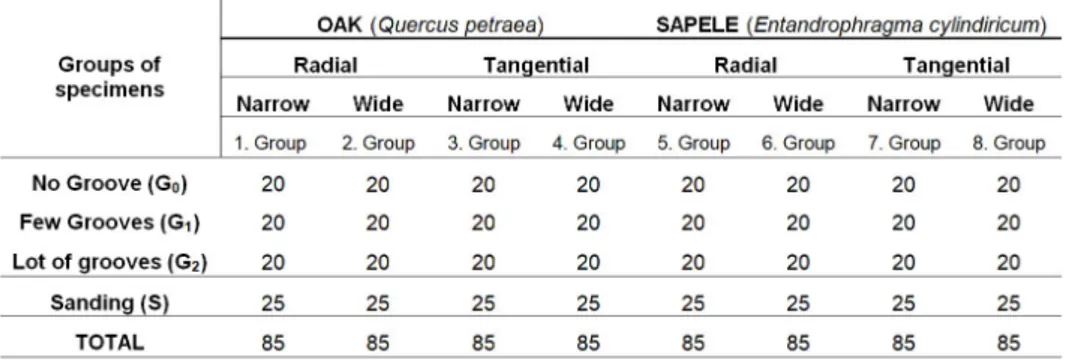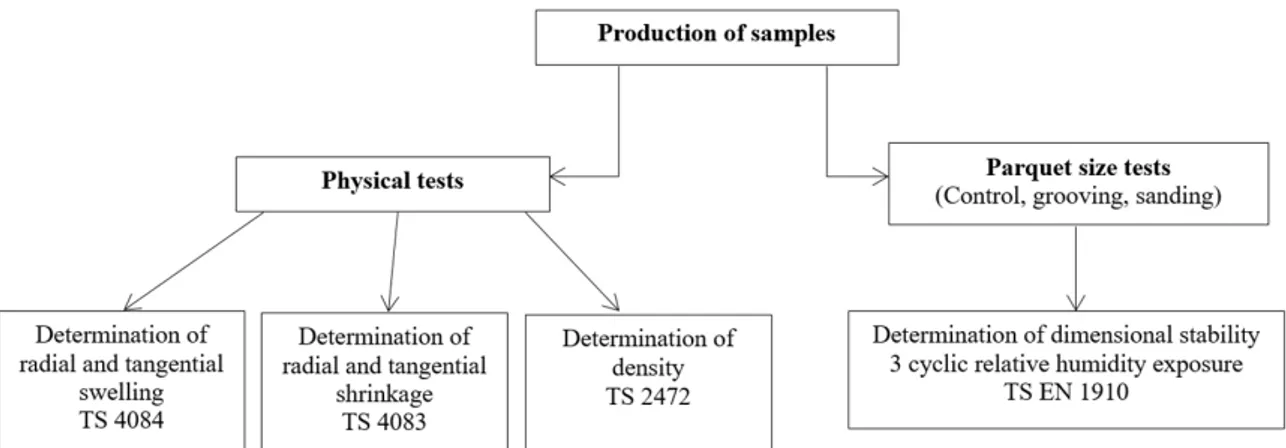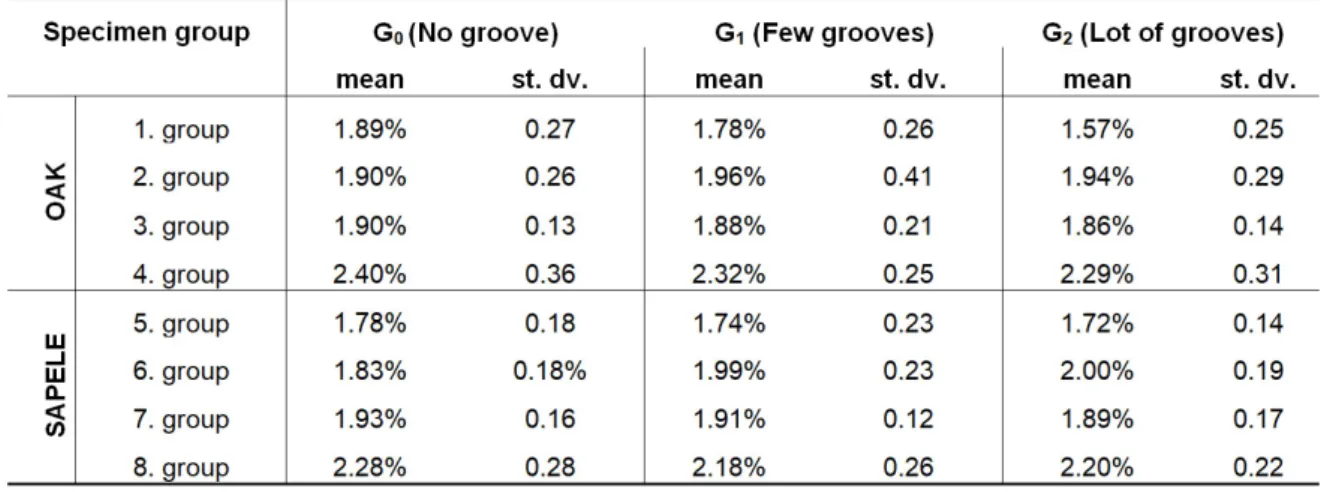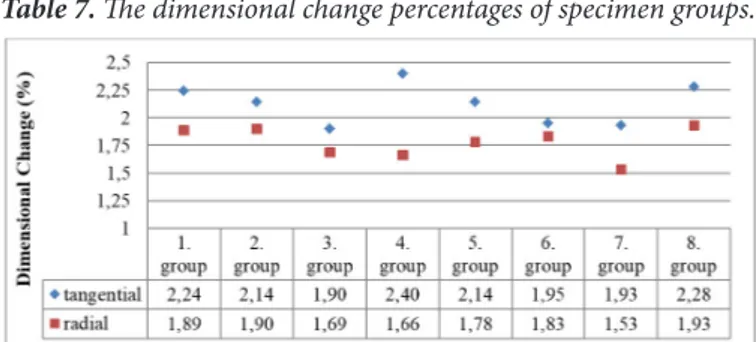The effect of cyclic relative
humidity exposure, sanding and
grooving on the dimensional
stability of solid wood parquet
Abstract
In this study, the effect of cyclic relative humidity changes, sanding and groov-ing on the dimensional stability of solid wood parquet were evaluated. The ex-periments were carried out on oak (Quercus petraea) and sapele (Entandrophrag-ma cylindiricum) wood species. Firstly some physical tests (density, shrinkage, and swelling) were carried out on 20×20×30 mm specimens obtained from these two species. After the physical tests the parquet size specimen groups were ob-tained both in radial and tangential section directions and in two sizes; narrow (250×50×15 mm) and wide (250×90×15 mm). One group of parquet size spec-imens was sanded and the other group was grooved. There was also a group of specimen for control.
After being conditioned to equilibrium moisture content at 65% relative hu-midity, specimens were placed in a climate chamber and exposed to cyclic rela-tive humidity changes. The dimensions of the specimens were measured between different environmental conditions and the dimensional change was evaluated by taking into consideration the mentioned physical properties. The results show that cyclic relative humidity changes mainly resulted with an increase in the di-mensional stability of sanded and cyclic conditioned specimens. There was not a significant change in the dimensional stability of grooved specimens.
Keywords
Solid wood parquet, Dimensional stability, Sanding, Grooving, Cyclic conditioning. Gülru KOCA1, Nihal ARIOĞLU2, Nusret AS3
1 gulru.koca@isikun.edu.tr • Department of Interior Architecture and Environmental Design, Faculty of Fine Arts, Işık University, Istanbul, Turkey 2 nihalarioglu@beykent.edu.tr • Department of Architecture, Faculty of Engineering and Architecture, Beykent University, Istanbul, Turkey
3nusretas@istanbul.edu.tr • Department of Forest Industry Engineering, Faculty of Forestry, Istanbul University Cerrahpaşa, Istanbul, Turkey
Received: January 2018 •Final Acceptance: September 2018
do
i: 10.5505/i
tu
1. Introduction
Wood is an important organic ma-terial which is commonly used in the construction industry. It is mechani-cally strong, light in weight, resistant to various factors and it is visually attrac-tive (Bekhta & Niemz, 2003; Juodeik-iené, 2013). Wood is also a renewable and an environment-friendly material (Chotikhun & Hızıroğlu, 2016). It can be used safely as a structural material, but it is more commonly used as a fin-ishing (floor, wall, ceiling claddings), mostly as a flooring material (Hytti-nen et al., 2010). The most important reasons for preference of wood are; its visual properties and warm surface temperature. However, flooring ma-terials should also have some other specific properties such as; high com-pressive strength, dimensional stabili-ty, heat and noise control, abrasion re-sistance and adhesion capacity. When wood is evaluated according to these properties, it can be stated that it has a higher performance than most of the other building materials. Thus, wood is used as a flooring material for centu-ries (Németh et al, 2014; Toydemir et al., 2000).
Despite many advantages, wood can easily be affected by the changes of moisture content. The porous structure of wood desorbs and absorbs water/ water vapor to its cells and as a result the wood shrinks and swells (FPL, 1957; Juodeikiené, 2013; Tomak et al., 2014). This behavior is called “wood movement” which plays an important role in the physical deterioration and shortens the service life of the material.
In general wood’s movement is af-fected by; moisture content, density, content of extractives, mechanical stress and abnormalities in wood’s structure. Among these factors, mois-ture content is the most important one because the others are reasoning from wood’s structure but moisture content depends on the relative humidity of the surrounding air and cannot be con-trolled easily (Tsoumis, 1991).
The indoor air of a building is com-prised of temperature, relative humidi-ty, air, and heat movement. The balance of these constituents is effected by the materials and equipment used in con-struction. When they are evaluated;
humidity is said to be the most import-ant. Humidity fluctuations decreases the indoor air quality, cause formation of biological agents and cause shrink-age and swelling on building materi-als. Wood is one of the most affected building material from dimensional changes because of its natural origin (Wang & Tsai, 1998). Therefore the relative humidity changes in buildings has to be kept in a safe range (Melin & Bjurman, 2017). Also the shrinkage and swelling mechanism of wood has to be analyzed.
Water vapor is taken to the struc-ture of wood by the hydroxyl groups which is located on the cell wall and have a hydrophilic behavior. There-fore the interventions related to the dimensional stability of wood usually depends on creating a blockage be-tween the hydroxyl groups and wa-ter vapor to prevent absorption. The main dimensional stabilization tech-niques include; surface hydrophobi-zation, impregnation, chemical mod-ification and heat treatment (Kocaefe et al., 1991). Varnishing is used as a surface protection layer for parquets. The surface of solid wood parquet is varnished periodically. This layer pre-vents the absorption of water vapor and increase the dimensional stability to a certain extent. However because it is a very thin layer, varnish cannot prevent the movement of wood at hu-midity fluctuations.
Although the majority of dimen-sional stabilization interventions are dealing with surface treatment, there are some other physical applications which is said to be effective in im-proving dimensional stability; such as grooving, sanding and hygroscopic ageing. Flooring materials are man-ufactured with grooves at the back. Grooving the back of flooring materi-als shows which side is down, creates air movement, increases the adhesion surface and let the material lay flatter. Grooves are also said to increase the di-mensional stability, reduce the weight and decrease transportation costs (De-teix et al., 2012). Sanding is applied to flooring materials in order to remove layer of dirt and ensure flatness of the surface (Różańska, 2013). But because it decreases the thickness of the
materi-al and the movement of wood is direct-ly proportional with the dimensions of the material it can also be mentioned that it increases the dimensional stabil-ity. In addition, the ambient humidity changes cause a reduction in the move-ments of wood, which can be described as the hygroscopic ageing of wood (Es-teban et al, 2005).
The main aim of the study is to de-termine the effect of grooving, sanding and cyclic relative humidity changes on the dimensional stability of oak and sapele specimens. It was also aimed to determine and compare the behavior of narrow and wide specimens pre-pared in tangential and radial section directions.
2. Materials and methods 2.1. Materials
Solid wood parquet specimens were obtained according to TS 2039 (1988) standard and the same lumber group was used during the production stage in order to prevent different qualities between specimens. Oak (Quercus
pe-traea) and sapele (Entandrophragma cylindiricum) were used in the
man-ufacture of the specimens. 680 spec-imens were cut from oak and sapele wood. There were two reasons behind
the selection of these species; first their relatively more frequent use in the par-quet industry and second making a comparison between the imported and local species.
50 specimens of each wood species were used at physical tests which have 20×20×30 mm dimension. Parquet size specimens had different dimen-sions. Oak and sapele specimens were mainly cut in radial and tangential sec-tions. All radial and tangential oak and sapele specimens also had narrow and wide dimensions. Narrow specimens had a dimension of 250×50×15 mm and wide specimens had a dimension of 250×90×15 mm. Table 1 shows the groups and numbers of the specimens.
The sizes and the type of grooves is shown in Figure 1 and 2.
2.2. Methods
Physical tests were carried out to ensure the regularity of the specimens and to determine defects that might es-cape from visual inspection. Determi-nation of density (TS 2472, 1976), ra-dial and tangential swelling (TS 4084, 1983), radial and tangential shrinkage (TS 4083, 1983) tests were carried out on 20×20×30 mm specimens at this phase.
Figure 1. Narrow G0 (also S), G1 and G2 specimens.
Figure 2. Wide G0 (also S), G1 and G2 specimens.
Cyclic relative humidity exposure tests were carried out on parquet size specimens at humid and dry environ-mental conditions. After every cyclic exposure, the dimensions of the spec-imens were measured again in order to determine the dimensional change of specimens. Figure 3 illustrates the steps of the experimental stage.
Before the experimental campaign the specimens were conditioned in a room with a relative humidity of 65% and a temperature of 20°C (standard atmosphere) until they reach the equi-librium moisture content (12%).
2.2.1. Physical tests
Determination of density test was carried out according to TS 2472. Spec-imens were conditioned in a room with a relative humidity of 65% and a tem-perature of 20°C until the dimensional variation was smaller than 0.5%. The average density of the specimens was determined for a moisture content of 12% with the Formula 1;
ρ12% = m12% / V12% (g/cm3)
Here; m: mass (g)
V: volume (cm3)
Dimensions of the specimens (Fig-ure 4) were meas(Fig-ured with a caliper and mass of the specimens was weighed with an electronic weighing machine.
The radial and tangential swelling tests were carried out according to TS 4084. After conditioning the specimens at standard atmosphere then the radial and tangential swelling specimen group were dried in the oven at 103±2ºC. The radial and tangential dimensions were
measured with a caliper as lrmin and ltmin
after oven drying (0% moisture content).
After this period the specimens were kept in normal conditions for a while and submersed in distilled water at 5ºC until saturation (fiber saturation point). Then their radial and tangential dimensions were measured again as
lrmax and ltmax.
The linear swelling was determined with Formula 2;
The radial and tangential shrinkage was measured according to TS 4083. After conditioning the specimens at standard atmosphere, the radial and tangential shrinkage specimen group was submersed in distilled water at 5ºC until saturation (fiber saturation point). The radial and tangential di-mensions were measured with a
cali-per as lrmax and ltmax after water
soak-ing.
After this period the specimens were kept in normal conditions for a while and left in the oven at 103±2ºC. The
dimensions were measured as lrmin and
ltmin after oven drying.
The linear shrinkage was deter-mined with Formula 3;
Figure 3. Flow diagram of the experimental stage.
According to the results of physical tests; there are acceptable differences between literature and the test results (FPL, 1957). Therefore it can be stated that the specimens were obtained from regular planks and will not display an unusual behavior. The results of the physical tests are given in Table 2.
2.2.2. Parquet size tests
The main aim of the dimensional stability test is; comparing the dimen-sional change of the specimen between the initial standard climatic condition and another specified climatic condi-tion. The test was carried out according to TS EN 1910 (2003) standard.
The specimens were firstly condi-tioned in standard atmosphere to reach equilibrium moisture content (65% relative humidity, 20°C temperature). Their dimensions were measured and then they were exposed to cyclic hu-mid and dry environmental conditions in a climatic test chamber. Caliper was used for measuring the dimensions of
tangential and radial direction and me-ter was used for the longitudinal direc-tion. The experiments were carried out with a Climatic Test Chamber (Figure 5) in which the relative humidity and temperature could be programmed.
The environmental conditions and the time of exposure is given in Table 3. After each conditioning the dimen-sions of the specimens were measured again.
After conditioning the specimens at equilibrium moisture content, the di-mensions were measured as Di.
At the first part of the cycle the specimens were conditioned in humid environment. After four weeks condi-tioning at a temperature of 20±2ºC and 85% relative humidity the dimensions of the specimens were measured as
Dh. The second part of the first cycle
is conditioning the specimens in dry environment. After that the specimens were conditioned for four weeks at a temperature of 20±2ºC and 35% rela-tive humidity, then their dimensions
were measured again as Dd. After the
first cycle the dimensional change (dcr) of the specimens was determined in percentages with Formula 4;
Here;
dcr= the relative cumulative dimen-sional change as two digit fraction,
Di=dimension after normal condi-tioning,
Dd=dimension after dry condition-ing,
Dh= dimension after humid condi-tioning and
h= 18 (according to TS EN 1910) Figure 5. Climatic test chamber.
Table 2. Results of preliminary tests.
Thereafter the sanding (S) and cyclic
relative humidity specimens (G0) were
exposed to two more cycles, each cycle including a humid and dry environ-ment period. Sanding specimens had 15 mm thickness at first condition-ing, 12 mm at the second and 8 mm at the last conditioning. After every sanding process the specimens were conditioned and the dimensions were measured again in order to determine the effect of sanding on the
dimen-sional stability of parquet. Wide G0
specimens were also conditioned three times in order to determine the effect
of cyclic conditioning. G1 and G2
spec-imens were conditioned only once, to determine the effect of grooves on di-mensional stability.
On the basis of test results, the values were statistically analyzed by means of analysis of variance test (ANOVA) us-ing SPSS program (IBM, New York, USA). When ANOVA test result in-dicated a significant difference among factors, a comparison of the means was made by using Duncan’s multiple range test.
3. Results and discussion
Test results were evaluated to de-termine the effect of grooves, sanding and cyclic relative humidity changes on the dimensional stability of solid wood parquets.
3.1. Effect of grooves on dimensional stability
The radial and tangential dimen-sional changes of the grooved spec-imens as percentage were obtained (Table 4) after a cycle comprised of a
humid and dry relative humidity ex-posure. The dimensional changes were measured on the tangential, radial and longitudinal axis. Since longitu-dinal shrinkage and swelling of wood is negligible, as stated in the study of Constant et al. (2003), the results of di-mensional change on longitudinal axis were not evaluated.
In Table 4, 1. – 4. groups are oak specimens and 5 – 8 groups are sapele specimens as mentioned before in Ta-ble 1. According to the test results; the dimensions of the specimens mostly increased with increasing relative hu-midity values and decreased with de-creasing relative humidity values. Table 4. The tangential dimensional changes (%) of the grooved specimens.
Table 5. Dimensional change (%) of the grooved oak specimens.
Table 5 and 6 presents the results of dimensional changes of the grooved oak and sapele specimens. It was ob-served that, the increase in groove amount adversely affected the dimen-sional change at most of the specimen groups. The dimensional change de-creased with the increasing grooves as can be seen in 1, 3, 4, 5, and 7. speci-men groups.
A one-way analysis of variance (ANOVA) test was carried out at a 5% significance level in order to evaluate the relationship between grooves and wood’s movement. According to ANO-VA results, it is revealed that there is not a significant relationship between dimensional stability and grooves.
The results also revealed that; the dimensional change of tangential imens are higher than the radial spec-imens, as underlined in the study of
Booker et al. (1992). The tangential and radial dimensional change percentages of specimen groups are presented in Table 7 and the tangential dimensional change is higher than the radial dimen-sional change in all groups.
According to the results of the tests, the dimensional movement of wide specimens are also higher than the di-mensional movement of narrow speci-mens in all of the specimen groups as can be seen in Table 8.
3.2. Effect of sanding on dimensional stability
The specimens were sanded two times. At the first cycle they had 15 mm thickness, after the first sanding process their thickness decreased to 12 mm and after the second sanding they were 8 mm. The dimensional changes (%) after each sanding and cyclic rel-ative humidity exposure were given in Table 9.
According to the test results, it can be mentioned that dimensional stabil-ity of the specimens is improved after each sanding application. The most significant increase in dimensional sta-bility is obtained after the first sanding. The dimensional movement percent-age of all of the oak and sapele spec-imen groups has decreased as can be seen in Table 10 and 11.
According to the results of Dun-can’s test, S1 and S2 specimens have lower dimensional movement per-centages than S0 specimens of both oak and sapele groups. This finding is relevant to the hysteresis behavior of wood. Hysteresis is a complicated phenomenon of wood which basically means that wood’s equilibrium mois-ture content is different in desorption Table 7. The dimensional change percentages of specimen groups.
Table 8. The dimensional change percentages of narrow and wide
G1 specimen groups.
and sorption process and is not only related to relative humidity but also to the moisture history (Gunnar, 2011). The effect of the hysteresis is defined as a reduction of the apparent mois-ture capacity of wood (Rode & Clori-us; 2004).
3.3. Effect of cyclic relative humidity changes on dimensional stability
The dimensional changes of cyclic conditioning groups is given in Table 12.
According to the test results, it can be mentioned that the dimensional stability of the specimens is improved with cyclic conditioning. Table 13 and 14 presents the results of dimensional changes of the cyclic conditioned oak and sapele specimens.
As it can be seen in Table 13 and 14 the dimensional change percentage of oak and sapele has decreased in all of the specimen groups after each condi-tioning. The most significant decrease occurred at the second conditioning. According to the results of Duncan’s test, dimensional changes of the spec-imen groups are decreased and dspec-imen- dimen-sional stability is improved after each conditioning. This finding is relevant to the hysteresis behavior of wood.
4. Conclusion
The results revealed that; the dimen-sional change of tangential specimens are higher than the radial specimens and wide specimens are higher than the narrow specimens.
According to the test results, dimen-sions of most of the specimen groups increase with increasing relative hu-midity and decrease with decreasing relative humidity. When the influence of grooves is evaluated with statisti-cal analysis, the results revealed that grooves do not have a significant in-fluence on the improvement of dimen-sional stability for individual parquet specimens.
Nevertheless, dimensional stability is improved with sanding application. According to statistical analysis, every group is different from each other and dimensional stability increased after each sanding. The most significant in-crease is obtained after the first sand-ing. It has been thought as an
improve-ment because of hysteresis effect. The dimensional stability of the specimen groups were also increased with cyclic relative humidity changes. Statistical analysis results revealed that, dimen-sional movement decreased after each conditioning. These findings are rele-vant to the hysteresis behavior of wood as well.
Due to the results of the tests and analysis, sanding and cyclic condi-tioning can be recommended for im-proving dimensional stability. These applications can also be a part of the manufacturing process. Narrow par-quets with radial section is also recom-mended in flooring applications.
Although flooring materials are manufactured with grooves at the back for years, a satisfactory proof could not be obtained as an improvement in di-mensional stability of grooved speci-mens. However, adhesives also have an influence in increasing the dimensional stability of grooved specimens. Further investigation on the dimensional sta-bility of adhesives and grooves togeth-er is needed. Additional testing with different wood species and different relative humidity values would also be helpful in providing an additional step forward in dimensional movement be-havior of wood.
Table 10. Dimensional change (%) of the sanded oak specimens.
References
Bekhta P. & Niemz P. (2003). Effect of high temperature on the change in color, dimensional stability and me-chanical properties of spruce wood.
Holzforschung, 57(5), 539-546.
Booker R.R., Ward N. & Williams Q. (1992). A theory of cross-sectional shrinkage distortion and its experi-mental verification. Wood Science and
Technology, 26(5), 353-368.
Chotikhun A. & Hızıroğlu S. (2016). Measurement of dimensional stability of heat treated southern red oak (Quercus
falcate Michx.). Measurement, 87, 99-103.
Constant T., Badia M.A. & Mothe F. (2003). Dimensional stability of Doug-las fir and mixed beech – poplar ply-wood: experimental measurement and simulations. Wood Science and
Tech-nology, 37(1), 11-28.
Deteix J., Djoumna G., Blanchet P., Fortin A. & Cloutier A. (2012). Mini-mizing flooring strip weight: A shape optimization approach. Bioresources, 7(2), 1931-1947.
Eligon A.M., Achong A. & Saunders R. (1992). Moisture adsorption and desorption properties of some tropical woods. Journal of Materials Science, 27(13), 3442-3456.
Esteban L.G., Gril J., de Palacios P. & Guindeo Casasus A. (2005). Reduction of wood hygroscopicity and associated dimensional response by repeated hu-midity cycles. Annals of Forest Science, 62(3), 275-284.
Forest Service U.S. Department of Agriculture, (1957). Shrinking and
Swelling of Wood in Use (Forest
Prod-ucts Laboratory Report No. 736, 1957). Madison: Forest Products Laboratory.
Gunnar Salin J. (2011). Inclusion of the sorption hysteresis phenomenon in future drying models. Some basic con-siderations. Maderas Ciencia y
Tecnolo-gia, 13(2), 173-182.
Hyttinen M., Masalin-Weijo M., Kalliokoski P. & Pasanen P. (2010). Comparison of VOC emissions be-tween air-dried and heat-treated Nor-way spruce (Picea abies), Scots pine (Pinus sylvestris), and European aspen (Populus tremula) wood. Atmospheric
Environment, 44(38), 5028-5033.
Juodeikiené I. (2013). Influence of thermal treatment on the hygroscop-icity and dimensional stability of oak wood. Materials Science, 19(1), 51-55.
Kocaefe D., Huang X. & Kocaefe Y. (2015). Dimensional stabilization of wood. Current Forestry Reports, 1(3), 151-161.
Melin C.B. & Bjurman J. (2017). Moisture gradients in wood subjected to relative humidity and temperatures simulating indoor climate variations as found in museums and historic build-ings. Journal of Cultural Heritage, 25, Table 12. The dimensional changes (%) of the cyclic conditioned specimens.
Table 13. Dimensional change (%) of the cyclic conditioned oak
specimens.
Table 14. Dimensional change (%) of the cyclic conditioned sapele
157-162.
Németh R., Molnárne Posch P., Mol-nár S. & Bak M. (2014). Performance evaluation of strip parquet flooring panels after long-term in-service expo-sure. Drewno, 57(193), 119-134.
Rode C. & Clorius C.O. (2004).
Mod-eling of moisture transport in wood with hysteresis and temperature-dependent sorption characteristics. Performance
of Exterior Envelopes of Whole Build-ings IX Conference, Florida, December 5-10, Oak Ridge National Laboratory Press, USA.
Różańska A. (2013). FT-NIR
spec-tral analysis of the surface of samples obtained from wooden parquets of
19th century manor houses located in
South-Eastern Poland for determina-tion the manner and the soaked sub-stances. (IVALSA Tree Institute Report
Code: COST-STSM-ECOST-STSM-FP1006-230912-026985, 2013). Italy.
Tomak E.D., Ustaömer D., Yıldız S. & Pesman E. (2014). Changes in sur-face and mechanical properties of heat treated wood during natural weather-ing. Measurement, 53, 30-39.
Toydemir N., Gürdal E. & Tanaçan L. (2000). Yapı Elemanı Tasarımında
Malzeme (Material in Building Mem-ber Design). Istanbul, Turkey: Literatür
Publishing.
Turkish Standards. (1988).
Sol-id wood raw parquet blocks – Manu-factured from broadleaved wood (TS
2039). Istanbul: TSE.
Turkish Standards. (1976). Wood –
Determination of density for physical and mechanical tests (TS 2472).
Istan-bul: TSE.
Turkish Standards. (1983). Wood –
Determination of radial and tangential shrinkage (TS 4083). Istanbul: TSE.
Turkish Standards. (1983). Wood –
Determination of radial and tangential swelling (TS 4084). Istanbul: TSE.
Turkish Standards. (2003). Wood
and parquet flooring and wood paneling and cladding (TS EN 1910). Istanbul:
TSE.
Tsoumis G. (2009). Science and
Technology of Wood, Structure, Prop-erties, Utilization. Remagen, Germany:
Verlag Kessel.
Wang S.Y., Tsai M.J., (1998). Assess-ment of temperature and relative hu-midity conditioning performances of interior decoration materials. Journal






